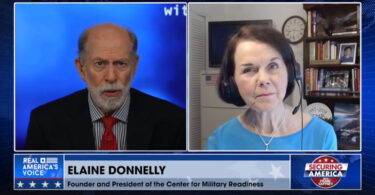By Brent D. Sadler, USNA ’94
Captain, US Navy, ret
Bio
Bottom Line Up Front:
Too many Americans believe the military, rightly or wrongly, has become politicized – that sadly is a fact that must be confronted. The effect has been historically bad recruiting numbers, that if unaddressed, likely will lead to tough retention statistics and degraded military morale and performance. Turning this around is a national imperative in these dangerous times.
Read PDF version of this statement given at “Ensuring Force Readiness: Examining Progressivism’s Impact on an All-Volunteer Military“, House Committee on Oversight and Accountability, Subcommittee on National Security, the Border, and Foreign Affairs hearing, 28 March 2023
Facts Should Matter:
The genesis of the current situation regarding the military’s perceived politicization begins in the summer of 2020. This was a time in which 570 violent or destructive demonstrations were occurring in which 11 people were killed and another 14 killed in incidents linked to political unrest as noted by the Armed Conflict Location & Event Data Project.
It was a time of high emotions for sure; a looming contentious Presidential election, frustration over pandemic lockdowns, and of course the killing of George Floyd while in police custody. Absent too often during those times was a focus on facts before making assertions of discrimination, systemic racism or extremism.
Despite what has transpired in the past three years, the military remains a potent fighting force. Nonetheless, the problems are real and serious and demand the attention of U.S. policymakers as a matter of national security.
At the Pentagon’s recently completed annual Diversity, Equity, and Inclusion (DEI) summit, the hosts boldly asserted “diversity is a strategic imperative” but failed to demonstrate how that goal leads to actually winning wars. Sadly, the objective too often for an optic, or in the often-heard words creating a military “that looks like America.”
Today when real world dangers abound, our military needs a laser focus on warfighting capability and capacity versus a preoccupation with optics. World War II Navajo code talkers show us how diversity, properly employed, can work.
Searches for Extremists and Racists in the Military Based on a Presumption of Guilt.
In the wake of the January 6, 2021, riot at the U.S. Capitol, which involved some ex-military members, Secretary Austin ordered a 60-day stand down to address extremism in the ranks and the creation of a DOD Countering Extremism Working Group. There was no evidence that this drastic measure was warranted.
According to the DOD’s own records, fewer than 100 members of the military have been “subject to official action due to engagement in prohibited extremist activity.”2 That number represents about 0.005 percent of the military out of 2.1 million active and reserve personnel.
Nevertheless, the DOD spent 5,359,000 hours on extremism prevention and over $500,000 on the stand down, not including the cost of compiling the report.3
Further, the DOD’s FY 2023 budget request contained $34.2 million for “countering extremist activities,” money for a problem that may not even exist.4
Gang activity not extremism was a larger, actual problem – but no stand downs held. The 2018 Gang and Domestic Extremist Activity Threat Assessment recorded only three interactions with police and service members having extremist associations, while 80 cases in the same time period had gang affiliations, which had the highest year-on-year growth rate increase.
Moreover, responding to a 2018 request from Rep. Keith Ellison, D-Minn., the Department of Defense reported only 27 incidents of extremist activity over the previous five years. More recently this past December, in its first annual report the Department of Defense, there were 211 allegations of prohibited activity (supremacist, extremists, gang, terrorism, racially motivated violent extremism, and anti-government extremism) of which 48 were subject to action (court martial, non-judicial punishment, administrative corrective action or other criminal prosecution).5 There remain inconsistencies in how the Services are reporting allegations and what types of allegations are being prosecuted, but the focus on facts is welcome and will likely serve to ensure actions match the problem.
Alienation not Inclusion.
While the DoD’s anti-extremism training materials were portrayed as benign and reasonable, evidence has shown that training proceeded to reflect leftist ideology.
Calls from service members to a hotline established by Senator Tom Cotton (R–AR) and Representative Dan Crenshaw (R–TX) reported being forced to participate in “privilege walks,” where members were required to separate themselves by race and gender to signify their “perceived privilege,” while other calls reported that they were encouraged to report other service members who voiced the belief that “All Lives Matter.”6
The effect was to alienate a population and stifle any opposing voices.
Task Force One Navy – A Service That Is Diverse:
Motivated by forces outside the Navy, “Task Force One” was established to look into diversity and equity in the Navy. In the Chief of Naval Operations’ July 1, 2020 memo establishing this group, he cited the turmoil inflamed by a contentious presidential campaign and the death of George Floyd.
This task force included a pledge to invest time to analyze “Navy-wide issues related to racism, sexism, ableism and other structural and interpersonal biases” and to “advocate for and acknowledge all lived experiences and intersectional identities of every Sailor in the Navy.”7
This effort cost nearly half a million dollars.8 The final report of this group was made public in January 2021, and painted a picture of a diverse and healthy military Service.
Unfortunately, Task Force One’s final report sadly provided little raw data, only anecdotal or subjective opinion surveys. Among its few factual findings:
- Minority junior officers enjoy higher retention rates than white officers.
- Retention rates for female officers are rising.
- There is no disparity in promotion rates up to mid-grade level officers, while minorities receive senior enlisted promotions at a higher rate than whites.
- The report did find a racial disparity favoring whites in senior officer promotions and junior enlisted promotions. It infers racism as the reason but offers no analysis of promotion boards to justify that conclusion.
The report acknowledges, however, that since 2000 the Navy has made significant strides at increasing its racial, gender and ethnic diversity. Its enlisted population today is 60 percent more racially diverse, 56 percent more gender diverse, and over 300 percent more ethnically diverse than 20 years ago.
Separately, according to annual Anti-Discrimination and Retaliation reporting required by the No Fear Act of 2002, regarding discrimination there is little recorded to suggest a major problem. Since 2016, only between four to 14 cases of actual discrimination have been found annually in an organization of more than 600,000 uniformed and civilian members.9
A good Task Force One recommendation was to add “respect” to the three core values—honor, courage, and commitment—of the Navy. Regrettably, however, a clear definition of “respect” is missing in the report.
The Navy merely offers that “respect” connotes “I see you and I hear you,” but it must mean much more if it is to truly achieve the type of diversity that actually elevates operational readiness—or, put another way, warfighting excellence.
To do that, respect must include a healthy intellectual curiosity for a range of views and experiences, so as to learn and incorporate elements that make the Navy team stronger. Unfortunately, such curiosity is not mentioned once in the report. Without this, bringing diverse people together in the military for better military effectiveness is lost in what equates to little more than balancing skin colors on crews of ships.
The report’s limited factual evidence provided for its many recommendations are statistics of accession, promotion, and retention broken out along racial categories. That’s interesting information, but without context, it’s incomplete.
Missing is more analysis for the “why” behind Navy promotion board decisions. Promotion board rationale for selection and non-selection is important feedback for aspiring officers and sailors.
A thorough review of those reasons would illustrate the root causes of poor performance, promotion, and accessions. Something the Task Force One report should have provided insights on.
Systemic racism or inequalities are mentioned seven times in the report, but it provides no specific cases or instances where an instruction, rule, or process was found to be inherently racist or promoting inequality. If, as the report concludes, there are systemic inequalities, what are they specifically and how will they be corrected immediately? This omission diminishes the report.
That said, the investment in education and associated outreach to more communities is warranted – perhaps more so in the search for new recruits. Those efforts should include reestablishing the BOOST program to assist officer candidates who are promising, but who have weak academics, and Naval Academy student exchange programs with historically minority institutions.
However, without an honest accounting of the facts behind the myriad symptoms detailed by Task Force One, the Navy runs the risk of chasing after what is easy or cheaper without making progress on recruiting.
Troubling, however, was the task force’s pledge taken by its members to “advocate and acknowledge all lived experiences and intersectional identities” and a focus on evaluating, among several other issues, “ableism.” Inclusion of that term suggests that in the course of its study, Task Force One may have become unmoored from the precepts of military service.
In fact, U.S. law requires that in order to qualify for military service, citizens must be “able-bodied.” So, in a way, the military must necessarily discriminate in favor of able-bodied individuals.
Elements of the Task Force One report, such as that, suggest influences that could lead to actions that reduce—rather than increase—military readiness. Hopefully, that pledge is just a fleeting statement intended to garner the broadest input, taken by those involved in researching and crafting the report.
But if it’s meant to be a clarion call to sustained action by apparatchiks judging the virtue of others against a fungible metric of “respect” or “ableism,” there is risk. That should not become a distraction from the meritocracy inherent in the technical and natural condition of being on a ship on an unrelenting sea.
Without an honest, fact-based, root-cause analysis of the Navy’s diversity challenges, it will never become the institution we need it to be.
The Trends:
Military readiness is defined here as the ability to accomplish the mission: to deter and fight wars. Every requirement levied on the military not associated with this understanding of readiness distracts it from being prepared for conflict putting all American lives at risk.
Poor Recruiting Success Is an Early Indicator.
While there are many indicators of looming problems, the current military recruiting crisis is the most salient. At the end of FY 2022 the Army fell 15,000 soldiers short of its recruiting goal, missing by 25 percent.10 The Army predicts that FY 2023 will be worse, estimating its end strength to be down by around 20,000 soldiers to a total of 450,000 active duty.11
The other services are also experiencing problems. The Marine Corps, Navy, and Air Force normally start a fiscal year with as many as half of their recruiting goals already recruited and contracted, but as of October 1, those percentages were off by as much as 50 percent.12
Sharp Drop in Americans ’Confidence in the U.S. Military:
- The Military Family Advisory Network found in a recent poll that the percentage of military and veteran families who would recommend military life had declined to 62.9 percent in 2021, down from 74.5 percent just three years ago in 2019.13 This decrease is especially concerning because military recruits tend to come from military families: According to U.S. Army Recruiting Command, 79 percent of recruits have relatives who served.14
- A February 2022 Pew Research poll reported that the percentage of Americans who had either a great deal or a fair amount of confidence in the military declined nine points between 2020 and 2021.15
- In July 2022 a Gallup poll described a five-point decline in American confidence in the U.S. military in just one year.
- Finally, and most alarming, in its November 2022 poll the Ronald Reagan Institute found that there had been a sharp decline in the trust and confidence in the U.S. military, with 70 percent saying they had “a great deal” of trust in 2018, dropping to 48 percent in 2022.16
Studies have shown that young people are very susceptible to career influence from individuals in their lives such as parents, relatives, guidance counselors, and teachers. When these less positive views of the American public regarding the military are widely shared, it negatively influences military recruiting and retention efforts.
Is Military Retention the Next Crisis?
There are indications that retention—the voluntary decision by service members to remain in the service beyond their initial enlistment or service obligation—is beginning to experience the same challenges as recruiting.
The Navy has stopped early discharges, is increasing incentives for sailors to remain in service, and recently erased all record of past physical fitness test failures.17
It is also reportedly offering bonuses to Naval Special Warfare sailors in order to improve retention.18
In the Air Force, fighter pilot retention has suffered over recent years.19
Indeed, the perception that non-warfighting missions are distracting senior military leadership may alienate experienced, skilled, and knowledgeable warfighters, incentivizing their early departure or, for those who remain, dampening their enthusiasm and contribution.
The Root Causes:
Perceived politicization and progressive policies foisted on the military in the recent past are proving harmful.
DEI:
DoD’s Sweeping Embrace of Diversity, Equity, and Inclusion (DEI) Ideology. One of the central organizing principles of the DoD has become to view all matters through the lens of DEI, which is inessential if not actively harmful to warfighting capabilities.
In its actualization DEI is distracting from developing a well-trained, merit-based military, and alienating. Ensuring equality of opportunity is vital for combat effectiveness because it allows the military to be selective within a larger pool of talented Americans willing to serve their nation and their fellow servicemen and women.
Critical Race Theory:
Critical Race Theory (CRT) is rooted in Marxism that claims that America is fatally flawed by systemic racism and ruled by white privilege.
The concept of CRT is anathema to the core principles of the U.S. military, CRT is inherently divisive as it sets out to categorize individuals into groups of oppressors and victims, which cannot be overcome unless the entire system is overturned.
Senior military leaders publicly deny the existence of instruction in CRT, but they have espoused knowingly or unknowingly its tenants:
- Chief of Naval Operations included How to Be an Antiracist, by Dr. Ibram Kendi, on his personal list of recommended professional readings – known for promoting discrimination.
- In June 2022, the U.S. Military Academy at West Point included curriculum materials on the problem of “whiteness.”20
- Air Force Academy encouraged cadets to apply to the Brooke Owens Fellowship; a nine-week paid internship for cadets interested in aerospace. The program, however, excludes “cisgender men.”21
Support of Partisan Purposes Within the DoD:
Public support for partisan progressive goals puts at risk the DoD’s apolitical nature while detracting efforts to improve warfighting capability. For example:
- DoD policies on abortion following the 2022 Dobbs v. Jackson Supreme Court decision;
- the military has promoted “Pride” events on military bases and official Twitter pages and featured “family friendly” drag queen performances; and,
- DoD joined in a “friend of the court” brief that argues the Constitution’s equal protection clause should continue to be suspended to facilitate colleges’ and universities’ use of racial preferences for admission.
Such actions on the part of DoD leaders perceived to stem from political motivations undermine the trust service members have in their leaders, contributing to diminished morale and cohesion. These actions also cost the military the public’s trust, which is crucial for recruiting and support for the military at large.
Conclusion:
National defense should not be a partisan issue. All Americans share the common interest in a strong U.S. military and should be united in reducing obstacles that thwart the highest levels of readiness.
1 Politicization is defined here as the imposition of policies, programs, and messaging designed for political, not military, reasons.
2 U.S. Department of Defense, “Report on Countering Extremist Activity Within the Department of Defense,” December 2021, p. 8, https://media.defense.gov/2021/Dec/20/2002912573/-1/-1/0/REPORT-ON-COUNTERING-EXTREMIST-ACTIVITY-WITHIN-THE-DEPARTMENT-OF-DEFENSE.PDF (accessed February 3, 2023).
3 James M. Inhofe National Defense Authorization Act for Fiscal Year 2023, S. Rpt. 117–130, 117th Cong., 1st Sess., July 18, 2022, p. 159, https://www.congress.gov/117/crpt/srpt130/CRPT-117srpt130.pdf (accessed February 3, 2023).
4 U.S. Department of Defense, Defense Budget Overview, March 28, 2022, p. 4-35, https://comptroller.defense.gov/Portals/45/Documents/defbudget/FY2023/FY2023_Budget_Request_Overview_B ook.pdf (accessed February 3, 2023).
5 Annual Report to Congress Regarding DoD’s Progress on Implementing Fiscal Year 2021 National Defense Authorization Act Section 554 Requirements, pg. 12-13, https://media.defense.gov/2022/Dec/01/2003123744/-1/-
1/1/DODIG-2023-034.PDF (accessed March 22, 2023).
6 Emily Caldwell, “Reps. Crenshaw, Cotton Say They’re Getting Hundreds of Whistleblower Complaints from Armed Forces Members,” Dallas Morning News, June 15, 2021, https://www.dallasnews.com/news/politics/2021/06/15/reps-crenshaw-cotton-say-theyre-getting-hundreds-of-whistleblower-complaints-from-armed-forces-members/ (accessed February 2, 2023).
7 Task Force One Navy, Final Report, January 2021, p. 10, https://media.defense.gov/2021/Jan/26/2002570959/1/-1/1/TASK%20FORCE%20ONE%20NAVY%20FINAL%20REPORT.PDF (accessed February 10, 2023).
8 Response to a request for information from Congressman Tony Gonzales (R–TX).
9 “Notification and Federal Employee Anti-Discrimination and Retaliation (NO FEAR ACT of 2002),” Department of the Navy https://www.secnav.navy.mil/donhr/Site/pages/no-fear-act.aspx (accessed March 22, 2023).
10 Lolita C. Baldor, “Army Misses Recruiting Goal by 15,000 Soldiers,” Army Times, October 2, 2022, https://www.armytimes.com/news/your-army/2022/10/02/army-misses-recruiting-goal-by-15000-soldiers/ (accessed December 5, 2022).
11 Davis Winkie, “Citing Recruiting Woes, Army Will Shed up to 28,000 Troops in Next Year,” Army Times, July 19, 2022, https://www.armytimes.com/news/your-army/2022/07/19/army-will-be-up-to-28000-troops-
understrength-vice-chief-tells-congress/ (accessed February 6, 2023).
12 Michael Lee, “Army Misses Recruiting Goals While Other Branches Fall Behind for Next Year,” Fox News, October 2, 2022, https://www.foxnews.com/us/army-misses-recruiting-goals-while-other-branches-fall-behind-next-year (accessed February 6, 2023).
13 Military Family Advisory Network, “Military Family Support Programming Survey—2021 Results,” July 14, 2022, p.68, https://www.mfan.org/wp-content/uploads/2022/07/MFAN-Programming-Survey-Results.pdf (accessed February 6, 2023).
14U.S. Army Recruiting Command, Army Public Affairs Office, “Facts and Figures,” https://recruiting.army.mil/pao/facts_figures/ (accessed February 6, 2023).
15 Brian Kennedy, Alec Tyson, and Cary Funk, “Americans’ Trust in Scientists, Other Groups Declines,” Pew Research Center, February 15, 2022, https://www.pewresearch.org/science/2022/02/15/americans-trust-in-scientists-
other-groups-declines/ (accessed February 6, 2023).
16 Beacon Research, “US National Survey of Defense Attitudes on Behalf of the Ronald Reagan Foundation—Final Topline Results,” November 9–17, 2022, https://www.reaganfoundation.org/media/359964/rndf-survey-2022-topline.pdf (accessed February 6, 2023).
17 Konstantin Toropin, “Navy Canceling Early Discharges and Offering Extensions to Keep More Sailors in Uniform,” Military.com, June 29, 2022, https://www.military.com/daily-news/2022/06/29/navy-canceling-early-discharges-and-offering-extensions-keep-more-sailors-uniform.html (accessed February 6, 2023), and Heather Mongolio, “Navy Fitness Assessment Reset Latest Effort in Ongoing Retention and Recruitment Drive,” USNI News, February 21, 2023, https://news.usni.org/2023/02/21/navy-fitness-assessment-reset-latest-effort-in-ongoing-retention-and-recruitment-drive (accessed February 22, 2023).
18 Steve Balestrieri, “The US Navy Is Offering Its Most Experienced Special-Operations Sailors up to $100,000 to Stay in Uniform,” Business Insider, February 4, 2023, https://www.businessinsider.com/navy-offers-special-warfare-sailors-retention-bonuses-up-to-100000-2023-2 (accessed February 9, 2023).
19 Tobias Switzer, “The Air Force Pilot Retention Crisis Is Not Over,” War on the Rocks, October 20, 2020, https://warontherocks.com/2020/10/the-air-force-pilot-retention-crisis-is-not-over/ (accessed February 9, 2023), and John Venable, “U.S. Air Force,” in Wood, ed., 2023 Index of U.S. Military Strength.
20 Michael Pompeo, “America’s Military and Our Country Won’t Survive If Wokeism Continues to Rule,” Fox News, September 28, 2022, https://www.foxnews.com/opinion/america-military-our-country-wont-survive-if-wokeism-continues-rule (accessed February 2, 2023).
21 Brooke Owens Fellowship, “Apply,” https://www.brookeowensfellowship.org/apply (accessed February 3, 2023).








Leave a Comment